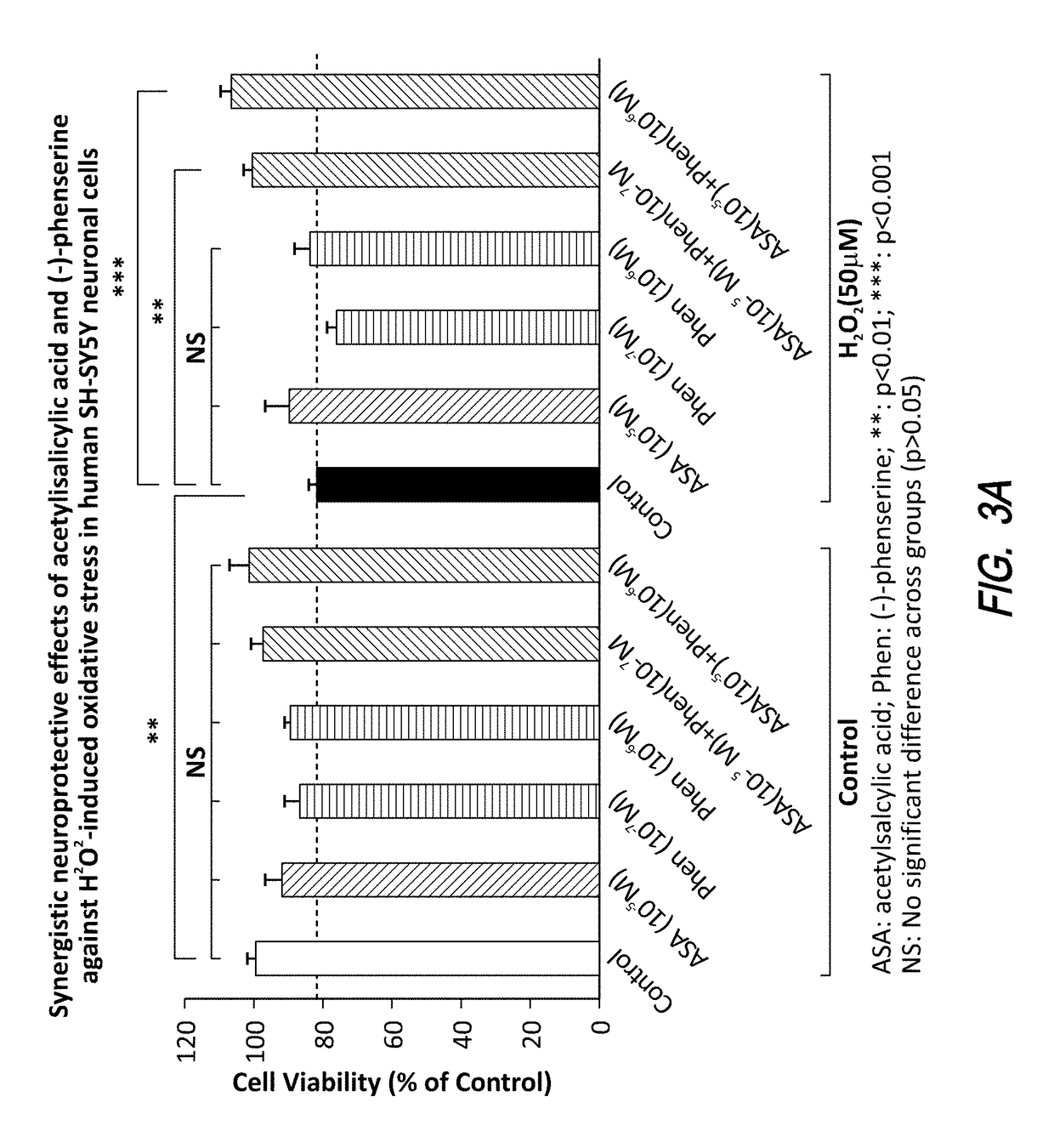Compositions and methods for treating concussion
a technology of concussion and compositions, applied in the field of compositions and methods for treating concussion, can solve the problems of head injuries providing a source of serious concern, overall risk of developing late-onset chronic traumatic encephalopathy, brain pathologies, etc., to prevent anecrotic cell death, and reduce the risk of brain trauma
- Summary
- Abstract
- Description
- Claims
- Application Information
AI Technical Summary
Benefits of technology
Problems solved by technology
Method used
Image
Examples
example 1
[0089]FIGS. 1A-1B provide support of the beneficial effects of phenserine on neurodegenerative pathologies important to brain traumas (e.g., traumatic brain injury, concussions, and sub-concussive injuries). Evidenced thereby is that the concentrations of phenserine and / or its metabolites (−)-N1, N8-bisnorphenylcarbamoyleseroline, (−)-N1-norphenylcarbamoyleserolined, and / or (−)-N8-norphenylcarbamoyleseroline exert anti-inflammatory and other genetic and molecular effects in the brain of both mice and humans. Briefly, human peripheral blood mononuclear cells (PBMCs) were isolated, from blood, then cultured and, in the presence and absence of phenserine for 24 h, challenged with phytohemagglutinin (PHA: 3 μg / mL; Sigma-Aldrich) to induce inflammation and cytokine production. The detection limit for these assays is <1 pg / mL for IL-1beta and <3 pg / mL for IL-10. The intra- and inter-assay CV was <10%. All results are expressed in picograms per milliliter. In these studies, phenserine (100...
example 2
[0090]Referring now to FIGS. 2A-2B, illustrated are the effects of phenserine and on neuroprotection from anecrotic cell death, particularly with respect to glutamate-induced excitotoxicity and (FIG. 2A) and (H2O2)-induced oxidative stress (FIG. 2B)—two stresses known to be induced by TBI and other brain traumas—in cell culture models of rat primary cortical neurons and human immortal neuronal cell line SH-SY5Y, respectively.
[0091]Briefly, cultured hippocampal neurons in triplicate were prepared from 18-20 day rat (Sprague Dawley) embryos and were cultured for 7 days. They were treated with phenserine (5 μM) followed by the addition of an excitotoxic concentration of glutamate (50 μM). Neuronal viability was assessed 24 h after addition of glutamate. The results are plotted as percent neuronal survival ±SEM. As shown in FIG. 2A, glutamate significantly reduced cell viability by 53.5%, which was mitigated by phenserine by a return to 73.5% of control levels. Human SH-SY5Y cells were ...
example 3
[0093]The combination of phenserine with the anti-inflammatory drug aspirin exerts a synergistic neuroprotective effect against H2O2-induced oxidative stress in human SH-SY5 neuronal cells (FIG. 3). The combination of phenserine with the anti-inflammatory drug naproxen exerts additive and / or synergistic neuroprotective and neurotrophic effects in human SH-SY5 neuronal cells (FIGS. 3B-3D).
[0094]Human SH-SY5Y neuronal cells were seeded in 96-well plates at a density of 1×105 cells per well and allowed to grow for 24 h. Cells were then treated with various concentrations of non-steroidal anti-inflammatory drugs, as illustrated with aspirin (ASA) (10−5 M) or phenserine (Phen) (10−7 M, 10−6 M) or combinations ASA and Phen for 2 h in low serum (0.5% serum) media. Thereafter, cells were challenged to oxidative stress by H2O2 addition to half of the wells at a final concentration of 50 μM. At 18 h thereafter a MTS assay was performed per the manufacturers protocol (Abcam, Cambridge, Mass.) ...
PUM
| Property | Measurement | Unit |
|---|---|---|
| concentration | aaaaa | aaaaa |
| time | aaaaa | aaaaa |
| time | aaaaa | aaaaa |
Abstract
Description
Claims
Application Information
 Login to View More
Login to View More - R&D
- Intellectual Property
- Life Sciences
- Materials
- Tech Scout
- Unparalleled Data Quality
- Higher Quality Content
- 60% Fewer Hallucinations
Browse by: Latest US Patents, China's latest patents, Technical Efficacy Thesaurus, Application Domain, Technology Topic, Popular Technical Reports.
© 2025 PatSnap. All rights reserved.Legal|Privacy policy|Modern Slavery Act Transparency Statement|Sitemap|About US| Contact US: help@patsnap.com



